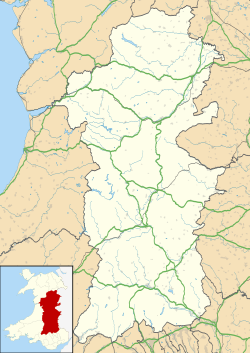Top Qs
Timeline
Chat
Perspective
Caersws
Village in Powys, Wales From Wikipedia, the free encyclopedia
Remove ads
Caersws (Welsh: Caersŵs; pronounced [kɑːɨrˈsuːs] ⓘ) is a village and community on the River Severn, in the Welsh county of Powys; it was formerly in Montgomeryshire. It is located 5 miles (8 km) west of Newtown, halfway between Aberystwyth and Shrewsbury. At the 2011 census, the community had a population of 1,586[1] – a figure which includes the settlements of Clatter, Llanwnnog and Pontdolgoch; the village itself had a population of slightly over 800.[2]
Remove ads
Etymology
Summarize
Perspective
The name is derived from the Welsh placename elements "Caer-" and "Sŵs". "Caer" translates as "fort" and likely refers to the Roman settlement. The derivation of the second element is less certain.
Thomas Pennant and later writers note that the fort was the termination of the Roman Road from Chester (via Meifod), the name of the road was Sarn Swsan or Sarn Swsog and it is thought that the town and the road share their etymology. The meaning of Swsan/Swsog is again, uncertain, but two local traditions hold that this is a personal name, either of a Queen Swswen (a name which may translate as "The Blessed/Pure Kiss") a Celtic leader who is said to have fought a battle in the vicinity around the time of the Roman occupation who was equated with Estrildis by Oliver Mathews,[3] or it is named for a Roman lieutenant "Hesus".[4][5][6]
Furthermore, the linguist John Rhys noted that the dialect of Mid-Wales Welsh (Y Bowyseg) was closer to the Gaulish language than its neighbours, and concluded that the area had pre-Roman links to Gaul. This may suggest a link between Caersŵs and the God Esus venerated by the Parisii and Treverii.[7][8]
Other suggested etymologies include the name retaining a Roman-era dedication to Zeus, and the fact that "sws" (not sŵs) can be literally translated to "Kiss" in modern Welsh has led to a number of developing folk etymologies.
Remove ads
History
Caersws was the location of two Roman forts of Roman Wales. Although the Mediolanum of the Antonine Itinerary has since been identified as Whitchurch in Shropshire, Caersws is sometimes identified as the Mediolanum among the Ordovices described in Ptolemy's Geography,[9] although others argue for Llanfyllin[10] or Meifod.[10][11] Further, this second Mediolanum may be identical or distinct from the "Mediomanum" (lit. "Central Hand") mentioned by the Ravenna Cosmography.[9]
Remove ads
Governance
An electoral ward in the same name exists. This ward includes the community of Carno and, at the 2011 Census, had a population of 2,316.[12]
Buildings
The Church of St Gwynog dates from the 15th century and was restored in 1863. It contains a 15th century rood screen and loft which the Royal Commission on the Ancient and Historical Monuments of Wales describes as "exceptional; the best-preserved of thirty known to have existed in the county".[13]
Maesmawr Hall, to the south-east of the village, was built in the early 19th century and is a Grade II* listed building.[14]
Remove ads
Transport
Caersws railway station is a stop on the Cambrian Line. Transport for Wales operates services between Aberystwyth/Pwllheli, Shrewsbury and Birmingham International.[15]
Sport
Downhill mountain biking has flourished in forestry at Henblas farm, to the north of the village, with a number of national races being held there. The current series, The Caersws Cup, began in March 2009.[16]
Cymru Alliance club Caersws F.C. are based in the village and play their home matches at the Recreation Ground.
Caersws is home to current and past champions of a number of sporting disciplines, leading some to christen it the "Sporting Capital of Wales".[17]
Remove ads
Notable people
- John Ceiriog Hughes (1832–1887), a Welsh poet and collector of Welsh folk tunes; also stationmaster and manager of the Van Railway from 1868 to 1887; buried in the churchyard at Llanwnnog.
- Mart Watkins (1880–1942), footballer with 161 club caps and 10 for Wales.
- Derek A. Traversi (1912–2005), a literary critic mainly for the British Council
- Phil Woosnam (1932–2013), former NASL commissioner and footballer with over 370 club caps and 17 for Wales.
Remove ads
Gallery
- One of Caersws’ four local pubs in 2010.
- The in town level crossing by Caersws station in 2010.
- A gated village Barrow Crossing/foot crossing in Caersws in 2010.
- Maesmawr Hall, a grade II* listed building
See also
References
Literature
External links
Wikiwand - on
Seamless Wikipedia browsing. On steroids.
Remove ads








